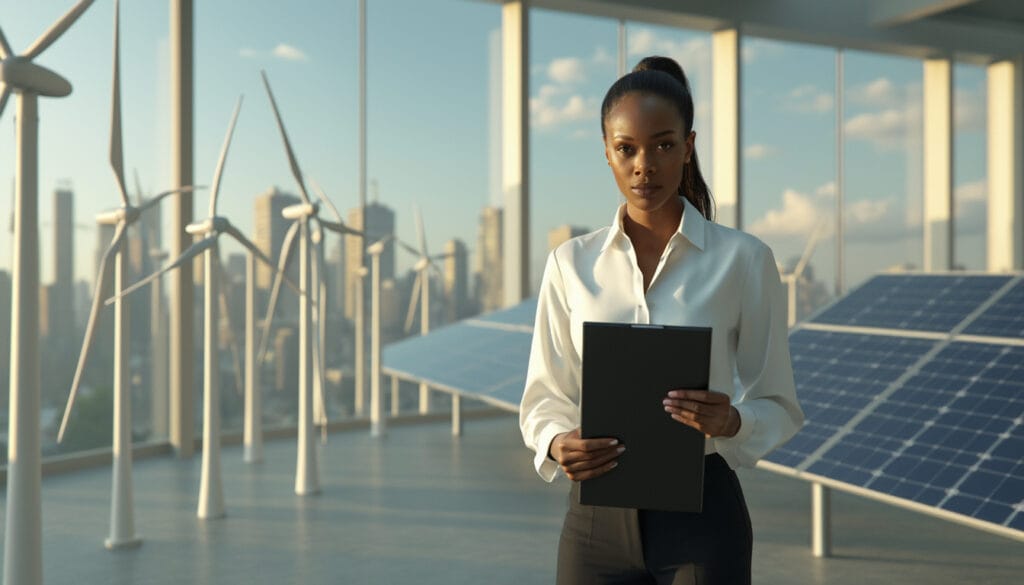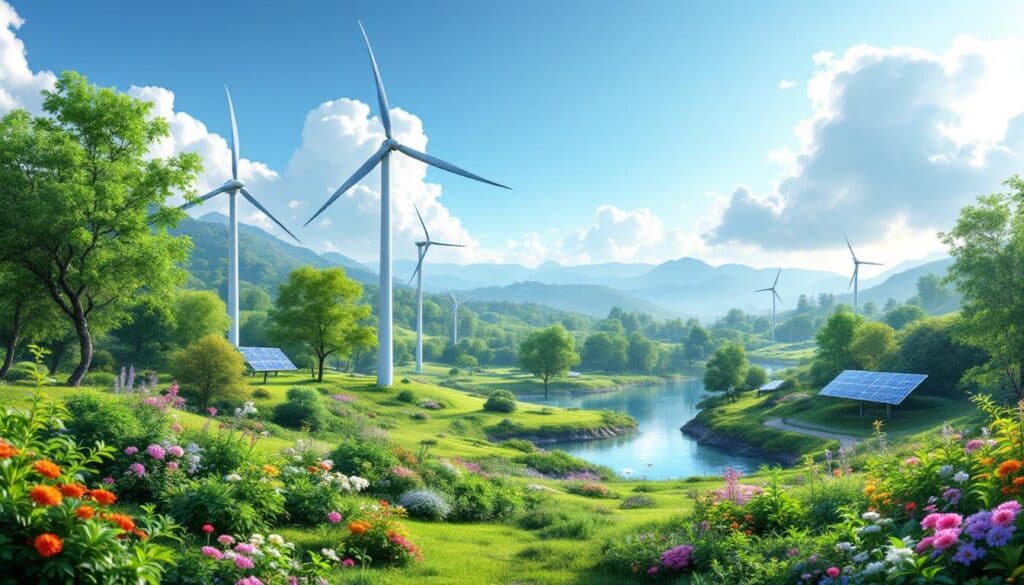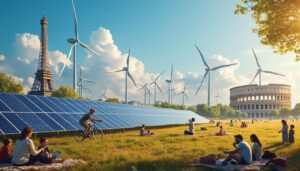The energy landscape is evolving rapidly.
Solar and wind energy now represent 20% of total capacity in the United States.
This advancement reflects an unprecedented enthusiasm for renewable energy sources.
However, not everyone shares this enthusiasm. An employee of an energy company expressed doubts on Reddit, stating that large-scale solar and wind production is unrealistic and that relying on these energies to meet climate goals is laughable.
The rise of renewable energies is not just a passing fad. In response to the devastating effects of gas and coal power plants, which not only pollute the air but also contribute to global warming, these sources offer a cleaner, more sustainable alternative. According to the World Resources Institute, generating 35% of electricity in the western United States from wind and solar would reduce CO2 emissions by 25% to 45%. These significant reductions could mitigate negative impacts on our planet and improve air quality, thus reducing public health problems related to pollution.
Despite the commendable goals of green energies, their implementation poses challenges, particularly regarding the reliability of natural resources. Solar and wind energies depend on environmental conditions, which can lead to fluctuations in production. Fortunately, advances in technology and better management of human resources can compensate for these variables. Solutions such as energy storage and optimized operational practices help ensure a constant supply, even when natural resources are not ideal.
Another common obstacle to renewable energies is the high initial cost, particularly for the installation of residential solar panels. However, maintenance costs are generally lower than those of fossil fuel energy sources, and renewable resources never run out, providing long-term stability. Furthermore, the growing success of biogas projects demonstrates that organic waste can be transformed into renewable energy, thus contributing to a more circular and sustainable economy.
Globally, the adoption of renewable energies continues to strengthen. In 2023, clean energy sources reached a record share of 44% in Europe, while air pollution and energy production from polluting sources decreased by 19%. These advancements reflect a global movement towards a more environmentally friendly energy transition, where future generations will benefit from a healthier and more sustainable world.

Why is the feasibility of large-scale renewable energies being questioned?
In the current energy landscape, renewable energies such as solar and wind are increasingly prominent. However, despite significant technological advancements, some skeptics remain doubtful about the ability of these energy sources to meet society’s growing needs. A notable example of this questioning comes from an employee of an energy company who recently expressed doubts on Reddit, stating: “The idea that people believe in it… is laughable.” This statement raises crucial questions about the perception and reality of renewable energy solutions.
The criticisms from this employee highlight the intermittency of solar and wind energy, suggesting that their dependence on weather conditions makes them unreliable for stable energy production. However, this view does not take into account the technological advances made to overcome these challenges. Furthermore, the transition to clean energies is often seen as a major cultural and economic shift, which can feed skepticism. It is essential to demystify these preconceived notions and examine the real data on the effectiveness and viability of renewable energies.
To understand why this questioning persists, it is necessary to consider several factors, including high initial costs, necessary infrastructures, and resistance to change within traditional industries. Additionally, public perception can be influenced by erroneous or incomplete information about the actual capabilities of renewable energies. Ultimately, the discussion should rely on scientific data and concrete case studies to objectively evaluate the role of green energies in our energy future.
What are the technological advancements in solar and wind energy?
Technological advancements in the field of renewable energies have significantly improved the efficiency and cost-effectiveness of solar and wind systems. Thanks to innovation, solar panels have become more efficient and less expensive, while wind turbines benefit from more resilient materials and optimized designs to maximize energy production. These advancements have allowed renewables to represent about 20% of energy production capacity in the United States today, a figure that continues to grow. The energy transition may sometimes seem fraught with obstacles, but emerging technologies demonstrate immense potential for a more sustainable future.
Another crucial aspect of technological advancements is the development of energy storage systems. Next-generation batteries allow excess energy produced by solar panels and wind turbines to be stored, ensuring a stable supply even when weather conditions are not ideal. Additionally, the integration of artificial intelligence in power grid management optimizes energy distribution and reduces losses. These innovations directly address concerns about the intermittency of renewable sources, making their large-scale adoption increasingly viable.
Moreover, the economies of scale achieved through increased production of green technologies have led to a significant drop in costs. For example, the cost of solar panels has fallen by over 80% in the last decade, making the initial investment more affordable for individuals and businesses. These cost reductions, combined with government incentives and subsidies, promote wider adoption of renewable energy solutions. Furthermore, innovations in the field of windmills, inspired by the writings of Persian scholar Istakhri, demonstrate the importance of historical and cultural research in the development of modern technologies.
To learn more about the impact of technological advancements in the renewable energy sector, check out this analysis of renewable energy stocks, which highlights the performance of leading companies like First Solar.
How do renewable energies contribute to reducing CO2 emissions?
The adoption of renewable energies plays a crucial role in reducing CO2 emissions and combating global warming. According to the World Resources Institute, generating 35% of electricity using wind and solar in the western United States would reduce CO2 emissions by 25% to 45%. This significant decrease in atmospheric pollutants contributes to improving air quality and reducing associated public health issues, such as aggravated asthma, respiratory diseases, and even pollution-related deaths.
Additionally, gas or coal generators are among the primary sources of air pollution and carbon. By replacing these traditional sources with renewable alternatives, we not only reduce our carbon footprint but also protect ecosystems and biodiversity. For instance, reducing CO2 emissions helps limit ocean acidification, thereby preserving marine life and natural habitats.
Another advantage of clean energies is their positive impact on public health. Fewer pollutants in the air translate into a decrease in respiratory and cardiovascular diseases among the population. Moreover, the transition to renewable energy sources creates green jobs, promoting sustainable economic growth and contributing to community resilience in the face of climate changes.
Furthermore, the integration of renewable energies into the national energy mix helps diversify energy sources, thus reducing dependence on fossil fuels and the associated risks of fluctuations in oil and gas prices. This diversification enhances energy security and ensures a more stable and resilient energy supply in the face of economic or geopolitical crises.
To delve deeper into the impact of renewable energies on CO2 emissions, you can refer to this study which explores how wind and solar energy have surpassed electricity production from coal in the United States.
What are the economic challenges related to the installation of renewable energies?
One of the main challenges associated with the adoption of renewable energies lies in the high initial costs of the necessary infrastructures, such as the installation of solar panels or wind turbines. Although maintenance costs are generally lower compared to traditional energy sources like gas or coal, the initial investment can present a significant barrier, especially for small businesses and individuals. However, it’s important to consider these costs from a long-term perspective, where savings from reduced energy bills and tax incentives can offset the upfront investment.
Furthermore, financing biogas or biomass valorization projects often requires substantial capital and careful planning. Governments and financial institutions play a key role in providing grants, low-interest loans, and other forms of financial support to encourage the adoption of renewable energy solutions. These measures reduce reliance on external financing and facilitate the transition to cleaner energy sources.
Another economic aspect concerns the creation of green jobs. While the construction and maintenance of renewable infrastructures generate jobs, there is an inevitable transition for workers from traditional industries. Professional retraining programs and specialized training are essential to ensure that workers can adapt to the new opportunities offered by the bioenergy and waste management sectors. This transition is crucial to prevent job losses and promote a more sustainable economy.
Moreover, market competition between different energy sources can influence investment decisions. Government subsidies and incentive policies play a crucial role in creating a favorable environment for the growth of renewable energies. By fostering stable and predictable economic conditions, these policies encourage businesses to invest in green technologies and innovate to reduce costs and improve efficiency.
To learn more about new energy pricing and policies, check out this article which details measures taken by electricity providers to promote solar energy.
How is the reliability of renewable energies ensured?
One of the primary concerns regarding renewable energies is their reliability, especially due to dependence on weather conditions. However, thanks to technological breakthroughs and energy storage systems, the reliability of solar and wind energy sources has significantly increased. Large-capacity batteries allow for storing excess energy produced during favorable periods, thus ensuring a continuous supply even in the absence of wind or sunlight. This storage capacity is essential for compensating for natural fluctuations and guaranteeing stable energy production.
Moreover, the integration of smart grids facilitates dynamic management of energy distribution. Predictive algorithms analyze real-time data to anticipate production and demand, adjusting distribution accordingly. This proactive management reduces the risks of outages and optimizes the use of available resources. Improved weather forecasting also allows for anticipating production variations and better planning storage needs.
Another key factor is the diversification of renewable energy sources. By combining several types of green energies, such as solar, wind, hydropower, and biomass, a more robust and resilient energy network is created. This diversification mitigates the effects of unfavorable weather conditions on any single energy source and ensures continuous and reliable production.
Scalable infrastructures also play a crucial role in enhancing reliability. Modern wind turbines and solar panels are designed to be modular and easily expandable, allowing for increased production capacity without disrupting the overall operation of the energy system. This flexibility is vital to adapt to changing needs and future technological advancements.
To learn more about strategies ensuring the reliability of renewable energies, you can refer to this article which explores methods used to stabilize and optimize energy networks based on renewables.
The global expansion of renewable energies in 2023
The year 2023 marked a significant milestone in the global expansion of renewable energies. In Europe, clean energy sources reached a record level, accounting for 44% of total electricity production. This growth is the result of incentive policies, massive investments in renewable infrastructures, and increased public awareness of climate issues. The 19% decrease in atmospheric pollutants and production of energy from fossil sources demonstrates the effectiveness of the initiatives implemented.
In the United States, solar and wind have also surpassed electricity production from coal for the first time. This transition is supported by technological advancements, cost reductions, and an increase in production capacity. States like Arizona have adopted favorable policies, such as the minimum pricing for solar energy, encouraged by electricity providers like SRP who have set new standards for 2025. These measures ensure a stable and sustained demand for solar technologies, thus stimulating their large-scale adoption.
Globally, many countries are emerging as leaders in the field of renewable energies. Developing nations are investing heavily in bioenergy and waste management projects, transforming organic waste into renewable energy through innovative biogas projects. This trend contributes not only to the reduction of greenhouse gas emissions but also creates economic opportunities and green jobs in local communities.
Furthermore, international collaboration and the sharing of best practices play a crucial role in accelerating renewable expansion. Knowledge exchanges and partnerships between countries enable the dissemination of technological innovations and overcoming common challenges related to the energy transition. Initiatives such as the Green Deal for Europe or international climate agreements illustrate the global commitment to a more sustainable energy future.
To closely follow developments in renewable energies in 2023, check out this article which details how wind and solar energy have surpassed electricity production from coal in the United States.
What are the feedback and opinions on renewable energies?
Opinions on renewable energies vary and reflect a diversity of viewpoints among experts, consumers, and stakeholders in the energy industry. While some ardently support the transition to clean energy sources, others express reservations about their long-term viability. On discussion platforms like Reddit, lively debates highlight these differences of opinion. For example, a key comment from a user politely expressed disagreement, pointing out that “it simply has to be used efficiently.”
Another user retorted by saying, “Just because renewable energy methods still have issues doesn’t mean we should throw the baby out with the bathwater. It’s still a very new concept. The planet needs it, so we have to keep working on it.” These exchanges illustrate the tension between the urgent need for an energy transition and concerns about the technical and economic challenges associated.
Many experts, such as Sophie, a researcher specializing in bioenergy and waste management, emphasize the importance of continuing to innovate and invest in renewable energies despite current challenges. According to her, “the valorization of biomasses and biogas projects are essential to transform organic waste into renewable energy, thus reducing our dependence on fossil fuels.” These initiatives are crucial for achieving climate goals and promoting a greener economy.
User testimonials on social media and forums also show a growing interest in sustainable energy solutions. Many recognize the environmental benefits of these energy sources while calling for continuous improvements to ensure their efficiency and reliability. This duality of opinions underscores the need for open and constructive dialogue to address concerns while strengthening support for green initiatives.
To further explore the discussions and opinions on renewable energies, you can refer to this article which examines the writings of Istakhri, a Persian scholar, on windmills, revealing historical and contemporary perspectives on renewable technologies.
Articles similaires
Thank you!
We will contact you soon.














